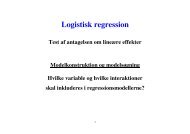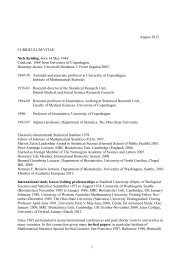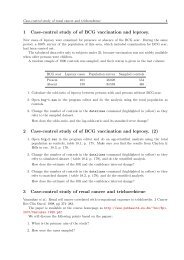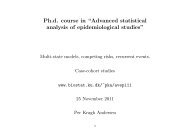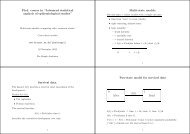Demography and epidemiology: Practical use of the Lexis diagram ...
Demography and epidemiology: Practical use of the Lexis diagram ...
Demography and epidemiology: Practical use of the Lexis diagram ...
Create successful ePaper yourself
Turn your PDF publications into a flip-book with our unique Google optimized e-Paper software.
28 Renal-ex.R<br />
Exp<strong>and</strong> Entry Exit Fail Time ptnr sex ddate birth rem<br />
1 1 1996.013 1996.263 0 2.50 17 1 1993.513 1967.944 0<br />
2 1 1996.263 1996.513 0 2.75 17 1 1993.513 1967.944 0<br />
3 1 1996.513 1996.763 0 3.00 17 1 1993.513 1967.944 0<br />
4 1 1996.763 1997.013 0 3.25 17 1 1993.513 1967.944 0<br />
5 1 1997.013 1997.094 1 3.50 17 1 1993.513 1967.944 0<br />
6 2 1989.535 1989.785 0 2.50 26 2 1987.035 1959.306 0<br />
7 2 1989.785 1989.814 0 2.75 26 2 1987.035 1959.306 0<br />
8 3 1989.814 1990.035 0 2.75 26 2 1987.035 1959.306 1<br />
9 3 1990.035 1990.285 0 3.00 26 2 1987.035 1959.306 1<br />
10 3 1990.285 1990.535 0 3.25 26 2 1987.035 1959.306 1<br />
> # Define relevant timing variables<br />
> spl$age.in spl$age.cur spl$Y <br />
> # Poisson model that resembles <strong>the</strong> Cox-model with<br />
> # ma # sex + I((ddate-birth-50)/10) + rem, data=tot )<br />
> pa summary( pa )<br />
Call:<br />
glm(formula = Fail ~ ns(Time, kn = c(6, 10, 14), Bo = c(2.5,<br />
20)) + sex + I((age.in - 50)/10) + rem + <strong>of</strong>fset(log(Y)),<br />
family = poisson, data = spl)<br />
Deviance Residuals:<br />
Min 1Q Median 3Q Max<br />
-0.4157 -0.2149 -0.1618 -0.1124 3.5342<br />
Coefficients:<br />
Estimate Std. Error z value Pr(>|z|)<br />
(Intercept) -3.32793 0.67638 -4.920 8.64e-07<br />
ns(Time, kn = c(6, 10, 14), Bo = c(2.5, 20))1 1.94131 0.59924 3.240 0.001197<br />
ns(Time, kn = c(6, 10, 14), Bo = c(2.5, 20))2 1.67060 0.61828 2.702 0.006892<br />
ns(Time, kn = c(6, 10, 14), Bo = c(2.5, 20))3 4.42812 1.38326 3.201 0.001368<br />
ns(Time, kn = c(6, 10, 14), Bo = c(2.5, 20))4 1.41944 0.57593 2.465 0.013717<br />
sex -0.07126 0.27467 -0.259 0.795286<br />
I((age.in - 50)/10) 0.53021 0.13679 3.876 0.000106<br />
rem -1.27862 0.38517 -3.320 0.000902<br />
(Dispersion parameter for poisson family taken to be 1)<br />
Null deviance: 746.99 on 4425 degrees <strong>of</strong> freedom<br />
Residual deviance: 701.86 on 4418 degrees <strong>of</strong> freedom<br />
AIC: 871.86<br />
Number <strong>of</strong> Fisher Scoring iterations: 7<br />
> # Show only <strong>the</strong> relevant regression parameters<br />
> round( ci.lin( pa, subset=length(coef(pa))-2:0, E=T )[,5:7], 3 )<br />
exp(Est.) 2.5% 97.5%<br />
sex 0.931 0.544 1.595<br />
I((age.in - 50)/10) 1.699 1.300 2.222<br />
rem 0.278 0.131 0.592<br />
> # - <strong>and</strong> <strong>the</strong>n <strong>the</strong> ones from <strong>the</strong> Cox-model<br />
> round( exp( ci.lin( ma )[,-(2:4)] ), 3 )<br />
Estimate 2.5% 97.5%<br />
sex 0.946 0.552 1.622<br />
I((ddate - birth - 50)/10) 1.685 1.290 2.202<br />
rem 0.283 0.133 0.602<br />
><br />
> # But we are using a spline form <strong>of</strong> <strong>the</strong> time since entry<br />
> # <strong>and</strong> a linear form <strong>of</strong> age at entry / current age.<br />
> # We could enter ei<strong>the</strong>r or both <strong>of</strong> <strong>the</strong>se in non-linear form.<br />
><br />
> # First all three (t: time, a: current age, e: entry age)<br />
> p.tae summary( p.tae )<br />
Call:<br />
glm(formula = Fail ~ ns(Time, kn = c(6, 10, 14), Bo = c(2.5,<br />
20)) + ns(age.in, kn = c(35, 45, 55), Bo = c(20, 65)) + ns(age.cur,<br />
kn = c(35, 45, 55), Bo = c(20, 65)) + sex + rem + <strong>of</strong>fset(log(Y)),<br />
family = poisson, data = spl)



